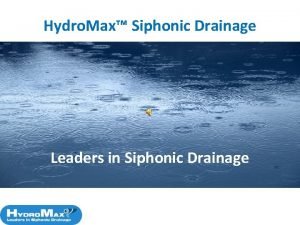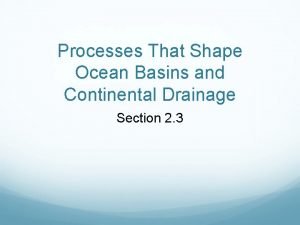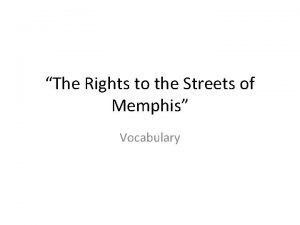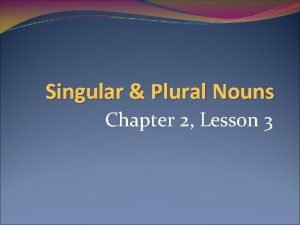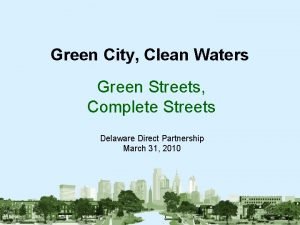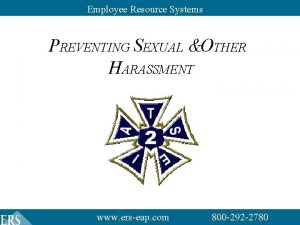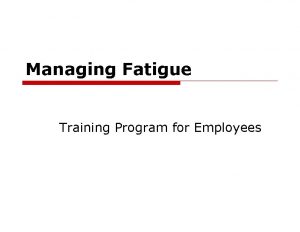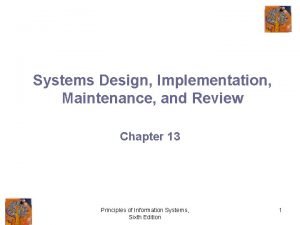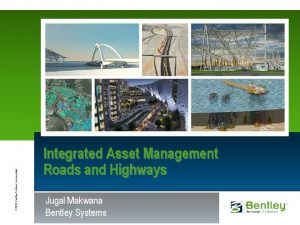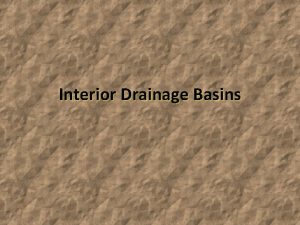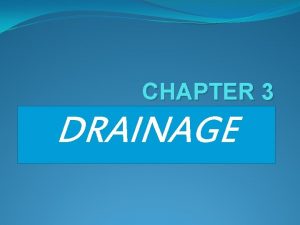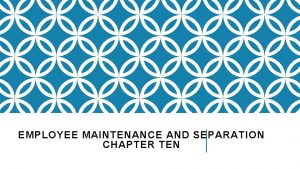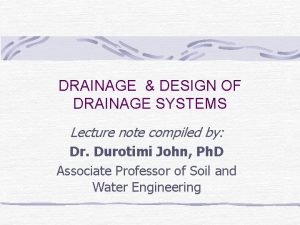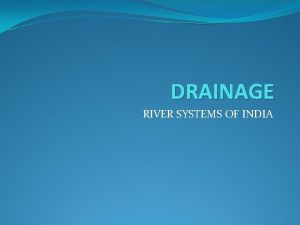MS 4 Maintenance Streets Drainage Systems Employee Training























- Slides: 23

MS 4 Maintenance (Streets & Drainage Systems) Employee Training Series Green Country Stormwater Alliance (GCSA) May 19, 2017 Prepared by INCOG

Streets and Drainage Maintenance This presentation provides suggestions and ideas for controlling pollutants in storm water runoff for the following activities: Pavement Repair Paint Striping Storm Drain Inlet Cleaning Ditch Maintenance Reporting Pollution and Illegal Dumping Activities 2

Pavement Repair Vacuum the slurry and cuttings from sawcutting operations. Don’t allow the slurry to enter the storm drain or to remain on pavement to dry out. Properly dispose of the slurry to prevent a discharge into the storm water system or a water body. 3

Pavement Repair Require concrete trucks to wash out in a designated location where wash water will not drain to a storm drain, drainage ditch or creek. Locate stockpiles of asphalt patching material on a concrete or other paved surface. Cover to prevent contact with rain. 4

Pavement Repair Mix only the amount of patching material necessary to complete the repair. Sweep up and properly dispose of all patching material that is not compacted or is left over from the repair. 5

Pavement Repair Use a biodegradable release agent (not diesel) for asphalt patching and cleanup activities. Clean trucks, equipment and tools in designated equipment wash facilities where wash water will not drain to a storm drain, ditch or surface water. 6

Pavement Repair If no wash facility is available, clean equipment over a layer of absorbent material spread on a paved surface and/or heavy plastic sheeting. Promptly sweep up the absorbent and dispose of properly. 7

Paint Striping Schedule painting and striping projects during dry weather only. Waste handling for waterbased (latex) paint: Pour small quantities of unused paint in open barrels and allow to dry. Dispose of dried paint in trash. Contain wash water used for equipment cleaning and dispose in sanitary sewer. 8

Paint Striping Waste handling for oil-based paint: Unused oil-based paint must be disposed of in accordance with established procedures. Dispose of solvents used for equipment cleaning in accordance with established procedures. 9

Hazardous Waste Disposal If you have a hazardous waste handling firm or individual you have been using and are comfortable with them, contact them with any questions you may have. Just make sure they have the equipment and expertise you need. 10

Storm Drain Inlet Cleaning After dewatering, trash and debris removed from storm water systems can go to a sanitary landfill. Report suspected dumping or pollution problems to supervisory personnel. 11

Storm Drain Inlet Cleaning Label inlets to the storm water system with a “Storm Water, NO DUMPING” message. 1312

Ditch Maintenance If an unknown pollutant is discovered, call someone with hazardous material (Hazmat) experience that has the expertise to determine the best course of action. This will depend upon the type of pollutant, concentration and volume you are dealing with. 13

Ditch Maintenance Contaminated sediments must be properly disposed of in accordance with local, state and federal regulations. 14

Ditch Maintenance Uncontaminated soil may be used onsite, offsite, stockpiled, used as fill or for other land applications. Cover soil stockpiles to prevent erosion and/or install a silt fence to capture sediment. 15

Ditch Maintenance Apply grass seed to exposed soils. A compost/mulch mixture applied with seed speeds vegetation growth and prevents erosion. Sod can also be used. If the channel experiences high velocities, turf reinforcement mats and/or check dams should be used to protect the channel until vegetation is established. 16

Salt and Sand Do not over-apply deicing salts and sand. Routinely calibrate spreaders. Alternative deicing agents are biodegradable, less toxic and less corrosive. Consider using calcium magnesium acetate (CMA), potassium acetate (KA) or another substitute for sodium or calcium chloride. 17

Street Sweeping streets after street fairs, art shows, parades, public events and street repairs can collect debris that would otherwise end up in the storm water system. Collected debris can be taken to a permitted landfill. 18

Report Pollution and Dumping Look for signs of pollution at the jobsite and during travel: Pipes or hoses in storm water drains Oil sheen on water surface Excess trash and debris Colored or cloudy water Dry weather flows Dead or dying fish Odor 19

Report Pollution and Dumping Report suspected pollution problems to supervisory personnel or to the local ODEQ office. 20

Helpful Agencies For hazardous waste questions in Oklahoma, call 405 -702 -9128 and ask for Hazardous Waste Compliance Oklahoma Public Employee Occupation, Safety & Health: 405 -528 -1500 x 226 EPA RCRA/Superfund hotline number is: 1 -800 -424 -9346 DOT Hazardous Materials Information Line: 202 -366 -4488 21

Helpful Agencies For reportable oil and chemical spills, call the National Response Center at: 800 -424 -8802 To talk to the ODEQ Pollution Prevention Coordinator, call: 800 -869 -1400 or 405 -702 -9128 22

Preventing Storm Water Pollution: What We Can Do Protecting water quality requires that all employees do their part to prevent storm water pollution. 23
 Horizontal
Horizontal Employee attitudes and employee performance
Employee attitudes and employee performance Golf course drainage
Golf course drainage Continental drainage systems
Continental drainage systems The rights to the streets of memphis answers
The rights to the streets of memphis answers Point to point drawing
Point to point drawing Plural library
Plural library What point is juliet making when she speaks these lines
What point is juliet making when she speaks these lines Green streets
Green streets What is prufrock's problem
What is prufrock's problem Sweet streets desserts
Sweet streets desserts Self-driving coalition for safer streets
Self-driving coalition for safer streets Rick kirkpatrick
Rick kirkpatrick How many roads man must walk down
How many roads man must walk down Employee resource systems
Employee resource systems Employee fatigue training
Employee fatigue training Introduction to employee training and development
Introduction to employee training and development Employee training methods
Employee training methods System maintenance and review
System maintenance and review Bentley exor
Bentley exor Iffco boiler
Iffco boiler Decision support systems and intelligent systems
Decision support systems and intelligent systems Engineering elegant systems: theory of systems engineering
Engineering elegant systems: theory of systems engineering Embedded systems vs cyber physical systems
Embedded systems vs cyber physical systems
